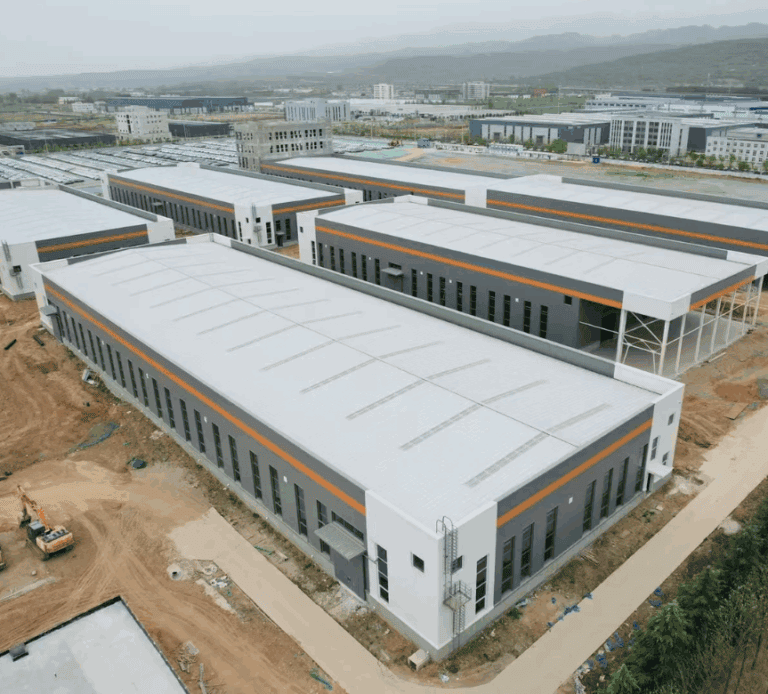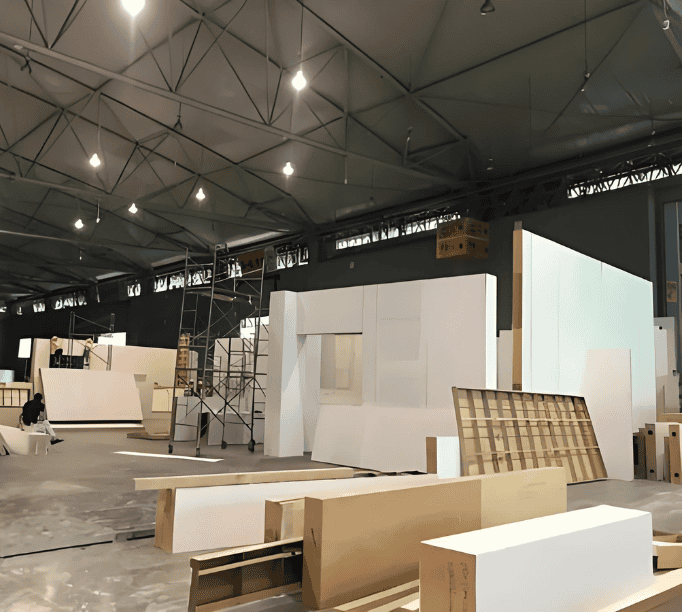Plazos ajustados. Mano de obra poco fiable. Demasiadas piezas móviles en la obra.
Si se ha enfrentado a alguna de estas situaciones, la construcción modular podría no ser solo una opción, sino la opción más inteligente. Pero ¿es la opción adecuada para su proyecto?
En esta guía, explicamos cómo funciona realmente un sistema modular en la práctica: cómo funciona, cuándo es más efectivo y qué debes saber antes de comprometerte. Respuestas directas, basadas en la experiencia real, sin publicidad engañosa.
Qué esperar en este blog:
¿Qué es exactamente la tecnología de construcción modular?
La construcción modular es un método de construcción en el que las estructuras se construyen fuera de obra en secciones —llamadas módulos— y luego se transportan al lugar final para su ensamblaje. Estos módulos se fabrican en fábrica, a menudo con un mejor control de la calidad, los materiales y los plazos.
Para profesionales de la construcción como usted, esto significa menos trabajo en el sitio, menos demoras y resultados más predecibles. A diferencia de la construcción tradicional, donde todo sucede en el lugar de trabajo, el sistema modular traslada gran parte del proceso a un entorno controlado.
En el núcleo de la construcción modular se encuentra precisión y repetibilidadCada módulo está diseñado para encajar perfectamente con los demás, como un rompecabezas. Por ello, las etapas de planificación e ingeniería son cruciales.
Las estructuras de acero desempeñan un papel fundamental en este caso. ¿Por qué? Porque el acero ofrece resistencia, estabilidad y flexibilidad, tres características fundamentales de los edificios modulares. Además, facilita la prediseñación de estructuras de acero, lo que acorta los ciclos de diseño y acelera la producción.
Si está acostumbrado a los métodos de construcción convencionales, la construcción modular podría parecer un gran cambio. Pero, en realidad, es simplemente una forma más inteligente y simplificada de poner en marcha edificios más rápido, con menos riesgos en el proceso.
¿Por qué los desarrolladores y contratistas están recurriendo al diseño modular?
En los últimos años, la construcción modular ha pasado de ser un nicho a ser algo común. Desarrolladores, contratistas y propietarios de proyectos ahora buscan ir más allá de los métodos tradicionales, y con razón.
El aumento de los costos laborales, los plazos más ajustados y la creciente demanda de precisión han impulsado a la industria a replantear la entrega de edificios. La construcción modular ofrece una manera de afrontar estas presiones sin sacrificar la calidad.
Esto es lo que impulsa el cambio:
- Entrega de proyectos más rápida
Los módulos se construyen fuera de la obra mientras el trabajo en la misma se realiza en paralelo. Esto puede reducir el plazo de entrega entre un 30% y un 50% en TP3T. - Más control, menos riesgo
La producción en fábrica implica menos sorpresas in situ. ¿Retrasos por mal tiempo? ¿Escasez de mano de obra? Mucho menos problemático. - Previsibilidad de costos
Precios más claros desde el principio, menos desperdicio de material y menos órdenes de cambio. - Mejor garantía de calidad
Los procesos repetidos en un entorno controlado conducen a resultados consistentes y a menos repeticiones de trabajos. - Mayor flexibilidad en el diseño
Modular no significa aburrido. Con estructuras de acero, se pueden lograr espacios abiertos, diseños modernos y acabados personalizados.
En resumen, la modularidad no es solo un método para ahorrar costos, sino también una estrategia de gestión de riesgos. Si trabaja en un mercado donde la velocidad y la certeza son importantes, quizás sea el momento de considerarlo con más detenimiento.
¿Cómo funciona el proceso de construcción modular?
Piense en la construcción modular como un flujo de trabajo paralelo. Mientras se prepara su terreno, su edificio ya se está construyendo, en otro lugar. Esa es la principal ventaja: velocidad sin concesiones.
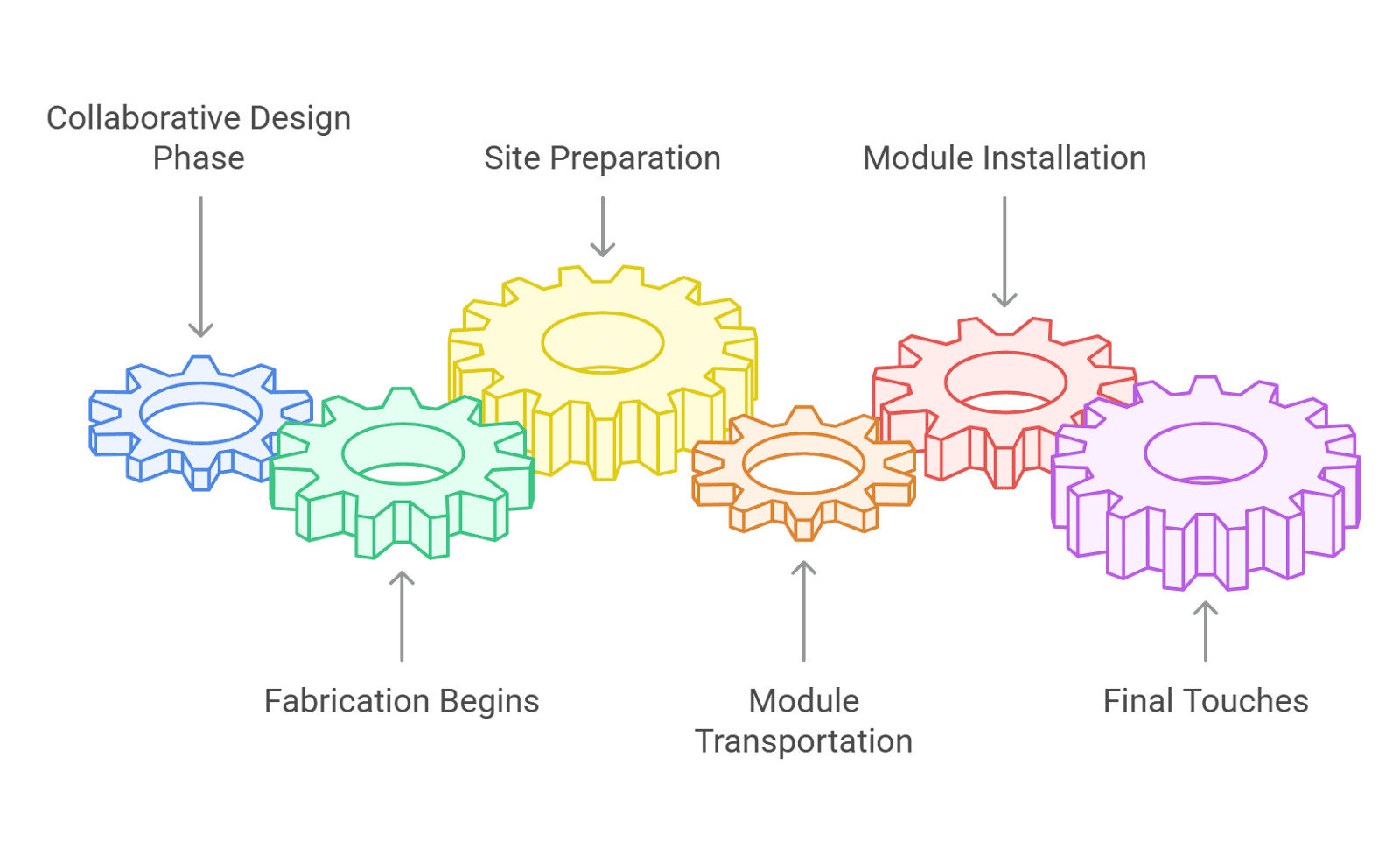
El proceso suele comenzar con una fase de diseño colaborativo. En ella, trabajamos estrechamente con su equipo para definir el diseño, las necesidades estructurales y las especificaciones de acabado. A diferencia de los proyectos tradicionales, donde las decisiones se posponen para etapas posteriores, el diseño modular requiere claridad inicial, pero esto se traduce posteriormente en velocidad y precisión.
Una vez definido el diseño, comienza la fabricación en un entorno de fábrica controlado. Cada módulo se construye según planos de ingeniería, utilizando estructuras de acero que garantizan precisión y resistencia. Se realizan controles de calidad en cada paso, desde la soldadura hasta el acabado.
Mientras tanto, en su obra, se preparan los cimientos en paralelo. Sin esperas. Cuando los módulos están listos, se transportan a la obra y se instalan con grúas, a menudo en tan solo unos días. Se sellan las conexiones, se conectan los servicios públicos y se realizan los últimos retoques en obra.
Durante todo este proceso, SteelPRO PEB es su socio de ingeniería y producción. No solo entregamos módulos, sino que también ofrecemos resultados predecibles. Siempre sabrá qué sucede, cuándo y por qué.
Mientras sus competidores todavía están vertiendo hormigón, usted podría estar entregando las llaves.
¿Cuáles son los beneficios prácticos para los propietarios de proyectos y contratistas?
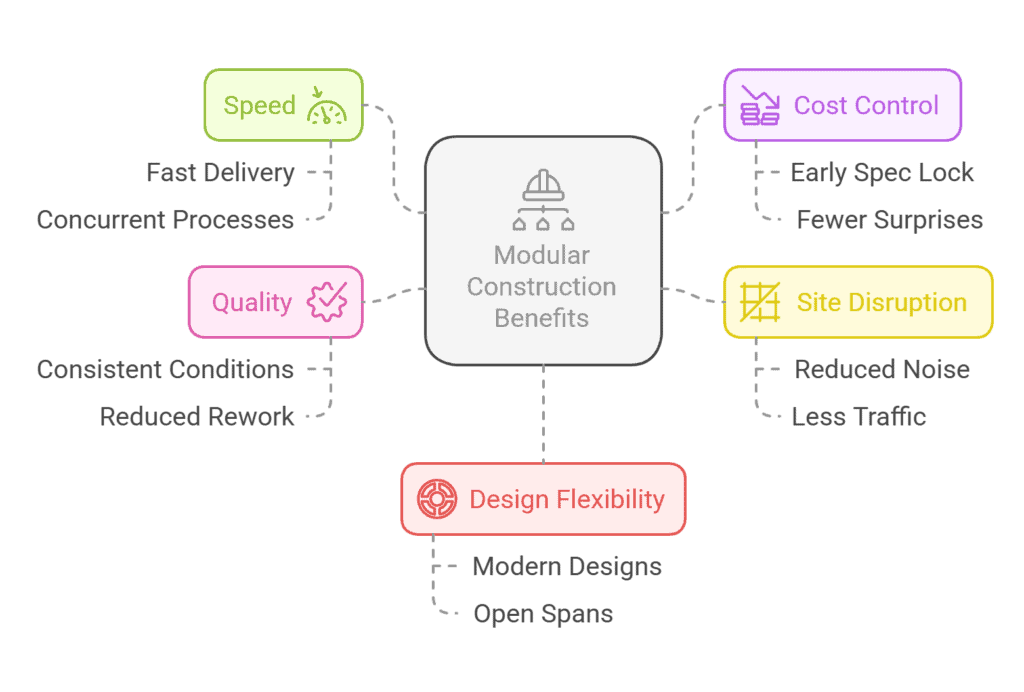
Velocidad que se adapta al mercado
Si trabaja con plazos ajustados, ya sea para cumplir con un contrato de arrendamiento, la demanda de un inversor o un objetivo operativo, la construcción modular le ofrece una gran ventaja. Dado que la fabricación se realiza fuera de la obra mientras se realiza la preparación del terreno in situ, la entrega puede ser hasta 50% más rápida que con los métodos convencionales.
Claridad y control de costos desde el primer día
Ya sabes lo a menudo que los presupuestos se disparan cuando las condiciones del sitio cambian o los materiales se agotan. Con la tecnología modular, se fijan las especificaciones con antelación y la mayor parte del trabajo se realiza en una fábrica con datos de entrada conocidos. Esto significa menos sorpresas, un control de costes más preciso y una programación más predecible.
Reducción de las interrupciones del sitio
Las obras de construcción pueden ser ruidosas, sucias y disruptivas, especialmente en entornos urbanos o de uso activo. Dado que la construcción modular reduce la actividad en la obra, se reducen el ruido, el tráfico y los problemas de seguridad. Es una forma más limpia y silenciosa de construir.
Mayor consistencia, menor repetición del trabajo
En las construcciones tradicionales, la calidad depende en gran medida de la mano de obra diaria y del clima. Los edificios modulares se fabrican en condiciones constantes, con procesos repetitivos y control de calidad integrado. Esto reduce las repeticiones y los defectos, y aumenta la confianza en la entrega.
Libertad de diseño con disciplina estructural
¿Te preocupa que modular sea sinónimo de "cuadrado"? Piénsalo de nuevo. Con las estructuras de acero, no estás limitado a diseños predefinidos. Puedes integrar diseños modernos, espacios abiertos y acabados de primera calidad, sin sacrificar la eficiencia que ofrece la modularidad.
¿Es la construcción modular siempre la opción adecuada?
La construcción modular ofrece mucho, pero no es la respuesta a todos los proyectos.
En realidad, no se trata de si la modularidad funciona. Se trata de dónde funciona mejor. El método en sí es muy eficiente, pero como cualquier enfoque de construcción, necesita las condiciones adecuadas para aprovechar al máximo su potencial.
El diseño modular funciona mejor cuando un proyecto cuenta con parámetros de planificación claros. Si el plazo es ajustado, el diseño es relativamente fijo y el acceso al sitio es predecible, el diseño modular puede reducir drásticamente la complejidad y el plazo de entrega. También es ideal cuando se trata de diseños repetibles, como aulas, dormitorios u oficinas.
Por otro lado, si su proyecto aún está en constante evolución (diseños que cambian con frecuencia, aprobaciones pendientes o un alcance incierto), la arquitectura modular podría no ofrecerle la flexibilidad necesaria. Asimismo, las obras con limitaciones logísticas extremas o estructuras únicas altamente personalizadas podrían ser más adecuadas para construcciones tradicionales o modelos híbridos.
La clave está en alinear las necesidades de su proyecto con las fortalezas del método. Ahí es donde la experiencia importa. En SteelPRO PEB, ayudamos a nuestros clientes a evaluar la viabilidad desde el principio, antes de comprometer cualquier inversión de diseño. Si es una buena opción, le mostraremos la hoja de ruta. Si no lo es, también se lo informaremos.
Cómo se construye un edificio modular de acero: un ejemplo de proyecto real
A continuación se muestra un ejemplo real de uno de nuestros clientes en el sudeste asiático.
Necesitaban un edificio administrativo de 1000 m² junto a su centro logístico, con un plazo de ejecución de seis meses. La construcción tradicional en su región habría tardado casi el doble. Optaron por una construcción modular de acero para cumplir con los objetivos de velocidad y coste.
Desde nuestra sede en China, nos encargamos del diseño completo, la fabricación de la estructura de acero y la producción de los módulos. Cada módulo se diseñó con dimensiones precisas, se preinstaló con el cableado eléctrico y las tolerancias mecánicas necesarias, y luego se embaló para su envío marítimo. Los módulos se cargaron en contenedores estándar o en plataformas planas, según el tamaño y la ruta de transporte.
Durante la producción, el cliente preparó su sitio localmente y contrató a su propio equipo de instalación. Proporcionamos documentación técnica completa, incluyendo puntos de izado, secuencia de instalación, mapas de interfaz de servicios públicos y planos de conexión de juntas, para facilitar el montaje in situ.
La entrega por mar tardó aproximadamente cuatro semanas. Una vez recibido el envío, el equipo local completó la instalación en poco más de dos semanas, con el apoyo de nuestro equipo de ingeniería en coordinación remota cuando fue necesario.
¿Todo fue listo para usar? No del todo, pero la estructura se montó sin problemas y, lo más importante, sin sorpresas. Eso es lo que ocurre cuando se combinan el diseño modular, el control de fábrica y una coordinación adecuada.
Con la planificación adecuada y un socio confiable, la tecnología modular no solo es más rápida, sino también más inteligente.
¿Qué debes tener en cuenta antes de seguir adelante?
Si está considerando seriamente la construcción modular, ya está un paso adelante. Pero antes de lanzarse, vale la pena detenerse para asegurarse de que el enfoque se ajuste a las necesidades de su proyecto y a las capacidades de su equipo.
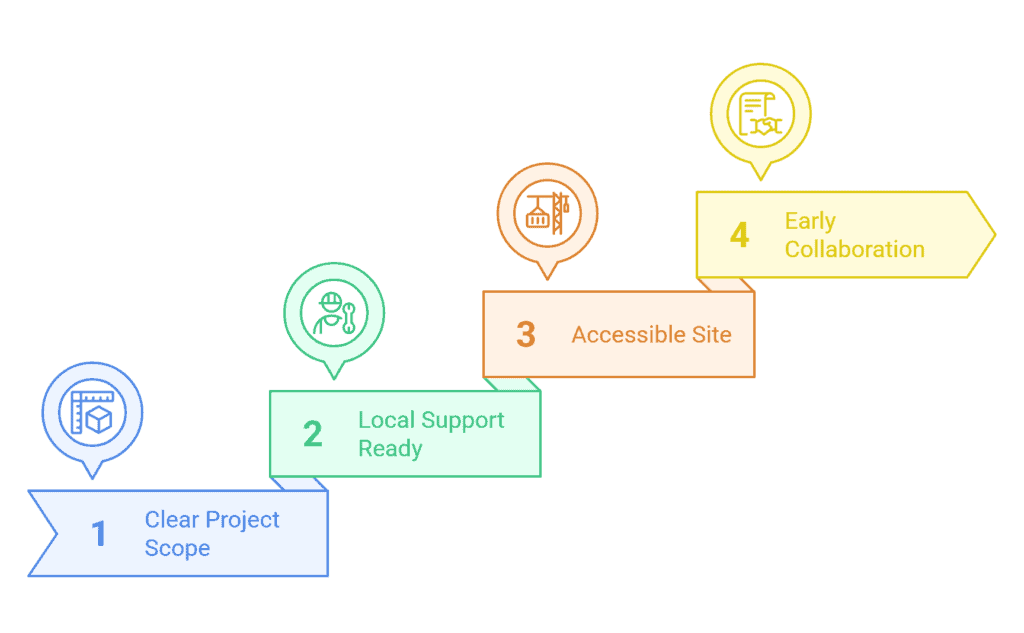
¿Es suficientemente claro el alcance de su proyecto?
El diseño modular se beneficia de la claridad inicial. Si su diseño cambia cada semana o si sus aprobaciones están a meses de distancia, los beneficios de la producción en fábrica pueden ser más difíciles de obtener. Un diseño fijo y especificaciones definidas ayudan a aprovechar al máximo la velocidad del diseño modular.
¿Dispone de soporte de instalación local listo?
Dado que entregamos módulos prefabricados, el montaje in situ lo realizan sus contratistas locales. Esta parte del proceso requiere planificación: equipo de elevación, coordinación de interfaces y personal experimentado. Le proporcionaremos planos técnicos y soporte remoto; y, si es necesario, también podemos enviar un ingeniero cualificado a sus instalaciones para que le ayude con la supervisión y coordinación durante la instalación. Pero es necesario que alguien de su equipo lo haga posible.
¿Su sitio es accesible para entrega modular?
Los módulos son grandes y suelen cargarse en estanterías planas o contenedores de gran capacidad. Su emplazamiento debe ser capaz de recibirlos y manipularlos: el acceso con grúa, el espacio de almacenamiento y las condiciones de las carreteras son factores más importantes que en las construcciones convencionales.
¿Estás listo para un tipo diferente de colaboración?
El diseño modular es rápido, pero requiere más participación inicial. Deberá tomar decisiones clave con mayor anticipación. Esto implica involucrar a su equipo de diseño, contratistas y socios de compras cuanto antes.
Ninguno de estos obstáculos es un obstáculo. Pero comprenderlos a tiempo marca la diferencia entre una construcción modular fluida y una frustrante.
Y si no estás seguro de alguno de los puntos anteriores, no te preocupes. Para eso estamos aquí.
¿Está listo para ver si el diseño modular es adecuado para su proyecto?
Hablemos.
Ya sea que esté planeando su primera construcción modular o buscando optimizar una existente, cuanto antes nos comuniquemos, mayor será el valor que podamos aportar. Comparta los detalles básicos de su proyecto: evaluaremos la viabilidad, detectaremos los riesgos y le mostraremos las posibilidades.
Sin conjeturas. Sin presiones. Solo respuestas directas de ingenieros con experiencia.
Envíanos el resumen de tu proyecto y Obtenga una evaluación preliminar gratuita—normalmente en un plazo de 24 horas.
→ Empiece la conversación hoy.
